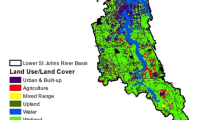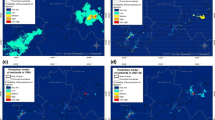Abstract
Wetlands provide many important goods and services to human societies, and generate nonuse values as well. Wetlands are also very sensitive ecosystems that are subject to much stress from human activities. Reducing the stress on wetlands requires a spatial matching between physical planning, hydrological and ecological processes, and economic activities. Spatially integrated modelling and evaluation can support this. The present study has developed a triple layer model that integrates information and concepts from social and natural sciences to address the analysis and evaluation of land-use scenarios for a wetlands area in the Netherlands, the Vecht area. This is the floodplain of river Vecht, located in the centre of the Netherlands. The study has resulted in a set of linked spatial hydrological, ecological and economic models, formulated at the level of grids and polders. The main activities incorporated in the system of models are housing, infrastructure, agriculture, recreation and nature conservation. The formulation of alternative development scenarios is dominated by land use and land cover options that are consistent with the stimulation of agriculture, nature or recreation. Two aggregate performance indicators have been constructed from model output, namely net present value of changes and environmental quality. The spatial characteristics of these indicators are retained in a spatial evaluation that ranks scenarios.
Similar content being viewed by others
References
R.K. Turner, J.C.J.M. van den Bergh, A. Barendregt and E. Maltby, Ecological-economic analysis of wetlands: Science and social science integration, in: Wetlands: Landscape and Institutional Perspectives, ed. T. Söderquist, Beijer Occasional Paper Series (Beijer International Institute of Ecological Economics, Stockholm, Sweden, 1998).
Anonymous, Convention on Wetlands of International Importance especially as Waterfowl Habitat, Ramsar, Iran, 2.2.1971, as amended by the Protocol of 3.12.1982 and the Amendments of 28.5.1987. United Nations Educational, Scientific and Cultural Organization (UNESCO), Paris, 13 July 1994 (1994).
E.B. Barbier, J.C. Burgess and C. Folke, Paradise Lost? The Ecological Economics of Biodiversity (Earthscan, London, 1994).
A. Barendregt, S.M.E. Stam and M.J. Wassen, Restoration of fen ecosystems in the Vecht River plain: cost–benefit analysis of hydrological alternatives, Hydrobiologica 233 (1992) 247–258.
A.J. Gilbert and R. Janssen, Use of environmental functions to communicate the values of a mangrove ecosystem under different management regimes, Ecological Economics 25(3) (1998) 323–346.
R. Brouwer, I.H. Langford, I.J. Bateman and R.K. Turner, A metaanalysis of wetland contingent valuation studies, Regional Environmental Change 1(1) (1999) 47–57.
J.C.J.M. van den Bergh, Ecological Economics and Sustainable Development: Theory, Methods and Applications (Edward Elgar, Cheltenham, 1996).
L.C. Braat and W.F.J. van Lierop, eds., Economic-Ecological Modelling (North-Holland, 1987).
R. Costanza, L. Wainger, C. Folke and K.-G. Mäler, Modeling complex ecological economic systems, BioScience 43 (1993) 545–555.
J. Zuchetto and A.M. Jansson, Resources and Society: A Systems Ecology Study of the Island of Gotland Sweden (Springer-Verlag, New York, 1985).
I.-G. Gren, C. Folke, K. Turner and I. Bateman, Primary and secondary values of wetland ecosystems, Environmental and Resource Economics 4 (1994) 55–74.
J.C.J.M. van den Bergh et al., Integrated analysis of wetlands: The Dutch Vechtstreek case study, Vol. 3 of ECOWET Report to EU, Ecological-Economic Analysis of Wetlands: Functions, Values and Dynamics, Norwich (1999).
VROM, Vierde Nota over de Ruimtelijke Ordening (Extra), Ministerie Volksgezondheid, Ruimtelijk Ordening en Milieu (Ministry of Public Housing, Spatial Planning and Environment), Den Haag (1990).
LNV, Natuurbeleidsplan (Nature Policy Plan), Ministerie van Landbouw, Natuur en Visserij (Ministry of Agriculture, Nature and Fisheries), Den Haag (1990).
M.G. McDonald and A.W. Harbaugh, A modular three-dimensional finite-difference groundwater flow model, USGS Virginia (1984).
Hill,? (1990).
M.G. McDonald, A.W. Harbaugh, R.O. Brennon and D.J. Ackerman, A method for converting no-flow cells to variable head cells for the U.S. Ecological survey modular finite-difference groundwater flow model, Virginia USGS, Open-file report 91–536 (1991).
D.E. Prudic, Documentation of a computer program to simulate stream aquifer relations using a modular, finite-difference groundwater flow model, Carson city Nevada, Open-file report 88–729 (1989).
A. Barendregt, M.J. Wassen and J.T. de Smidt, Hydro-ecological modelling in a polder landscape: a tool for wetland management, in: Landscape Ecology of a Stressed Environment, eds. C. Vos and P. Opdam (Chapman and Hall, London, 1993) pp. 79–99.
A. Barendregt and J.W. Nieuwenhuis, ICHORS, hydro-ecological relations by multi-dimensional modelling of observations, in: The Use of Hydro-Ecological Models in the Netherlands, eds. J.C. Hooghart and C.W.S. Posthumus (1993) pp. 11–30. Proceedings and Information No. 47, CHO-TNO, Delft.
P.W. Van Horssen, P.P. Schot and A. Barendregt, A GIS-based plant prediction model for wetland ecosystems, Landscape Ecology 14 (1999) 253–265.
D.J. Schaeffer, E.E. Herrinks and H.W. Kerster, Ecosystem health: 1 Measuring ecosystem health, Environmental Management 12 (1988) 445–455.
J.R. Karr, Biological integrity: a long-neglected aspect of water resource management, Ecologcal Applications 1 (1991) 66–84.
R. Costanza, B.G. Norton and B.D. Haskell, eds., Ecosystem Health (Island Press, Washington, DC, 1992).
E.C. van Ierland and N.Y.H. de Man, Sustainability of ecosystems: economic analysis, Study commissioned by the Dutch Advisory Council for Research on Nature and Environment and the Biological Council of the Royal Netherlands Academy of Arts and Sciences, Departments of General Economics, Wageningen Agricultural University (1993).
R.J. Steedman, Ecosystem health as management goal, Journal of the North American Benthological Society 13 (1994) 605–610.
C.S. Holling, D.W. Schindler, B.W. Walker and J. Roughgarden, Biodiversity in the functioning of ecosystems: an ecological synthesis, in: Biodiversity Conservation, eds. C. Perrings, K.-G. Mäler, C. Folke, C.S. Holling and B.-O. Jansson (Kluwer Academic Publishers, Dordrecht, 1995).
A. Ghilarov, What does ‘biodiversity’ mean – scientific problem or convenient myth?, Trends in Ecology & Evolution 11 (1996) 304–306.
C. Folke, Ecological principles and environmental economic analysis, in: Handbook of Environmental and Resource Economics, ed. J.C.J.M. van den Bergh (Edward Elgar, Cheltenham, 1999).
M. van Herwijnen, Spatial decision support for environmental management, PhD dissertation, Faculty of Economics and Econometrics, Vrije Universiteit, Amsterdam (1999).
M. van Herwijnen and P. Rietveld, Spatial dimensions in multicriteria analysis, in: Spatial Multicriteria Decision Making and Analysis; A Geographic Information Sciences Approach, ed. J.C. Thill (Ashgate, Brookfield, 1999) pp. 77–102.
R. Janssenand and M. van Herwijnen, DEFINITE A System to Support Decisions on A Finite Set of Alternatives (Kluwer Academic Publishers, Dordrecht, 1994).
E.J. Bos and J.C.J.M. van den Bergh, A cost–benefit analysis of sustainable nature policy in the Dutch VechtWetlands area, in: Comparative Environmental Economic Assessment, eds. R. Florax, P. Nijkamp and K. Willis (Edward Algar, Cheltenham, 2001).
Author information
Authors and Affiliations
Rights and permissions
About this article
Cite this article
van den Bergh, J., Barendregt, A., Gilbert, A. et al. Spatial Economic–Hydroecological Modelling and Evaluation of Land Use Impacts in the Vecht Wetlands Area. Environmental Modeling & Assessment 6, 87–100 (2001). https://doi.org/10.1023/A:1011591306323
Issue Date:
DOI: https://doi.org/10.1023/A:1011591306323




